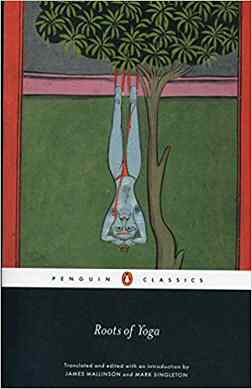Roots of Yoga
== Roots of Yoga ==
The Roots of Yoga is a comprehensive exploration of the origins and development of yoga, a group of physical, mental, and spiritual practices or disciplines which originated in ancient India. The book delves into the historical, philosophical, and cultural contexts that have shaped yoga over millennia.
Historical Background[edit | edit source]
Yoga has a rich history that dates back to the Indus Valley Civilization (c. 3300–1300 BCE). Archaeological findings, such as seals depicting figures in meditative postures, suggest that yoga practices were prevalent during this period. The earliest references to yoga are found in the Rigveda, one of the oldest sacred texts of Hinduism.
Philosophical Foundations[edit | edit source]
The philosophical underpinnings of yoga are rooted in various ancient Indian traditions, including Hinduism, Buddhism, and Jainism. The Upanishads, a collection of ancient Sanskrit texts, provide some of the earliest philosophical discussions on yoga. The Bhagavad Gita, a 700-verse Hindu scripture, also elaborates on the concept of yoga, particularly the paths of Karma Yoga, Bhakti Yoga, and Jnana Yoga.
Classical Yoga[edit | edit source]
The systematization of yoga is attributed to Patanjali, who compiled the Yoga Sutras around the 2nd century BCE. The Yoga Sutras outline the Eight Limbs of Yoga, which include ethical guidelines, physical postures (asanas), breath control (pranayama), and meditation (dhyana).
Medieval and Modern Developments[edit | edit source]
During the medieval period, various schools of yoga emerged, including Hatha Yoga, which focuses on physical postures and breath control. The Hatha Yoga Pradipika, written by Swatmarama in the 15th century, is a seminal text in this tradition.
In the modern era, yoga has been popularized globally through the efforts of various teachers and organizations. Figures such as Swami Vivekananda, Tirumalai Krishnamacharya, and B.K.S. Iyengar have played significant roles in bringing yoga to the Western world.
Practices and Techniques[edit | edit source]
Yoga encompasses a wide range of practices and techniques aimed at achieving physical health, mental clarity, and spiritual enlightenment. These include:
- Asanas: Physical postures designed to improve flexibility, strength, and balance.
- Pranayama: Breath control techniques that enhance respiratory function and energy flow.
- Meditation: Practices aimed at achieving mental focus and tranquility.
- Mantras: Sacred sounds or phrases used in meditation and ritual.
Cultural Impact[edit | edit source]
Yoga has had a profound impact on various aspects of culture, including art, literature, and medicine. It has also influenced contemporary wellness practices and has been integrated into various therapeutic modalities.
See Also[edit | edit source]
References[edit | edit source]
Further Reading[edit | edit source]
This article is a Yoga-related stub. You can help WikiMD by expanding it!
Search WikiMD
Ad.Tired of being Overweight? Try W8MD's physician weight loss program.
Semaglutide (Ozempic / Wegovy and Tirzepatide (Mounjaro / Zepbound) available.
Advertise on WikiMD
|
WikiMD's Wellness Encyclopedia |
| Let Food Be Thy Medicine Medicine Thy Food - Hippocrates |
Translate this page: - East Asian
中文,
日本,
한국어,
South Asian
हिन्दी,
தமிழ்,
తెలుగు,
Urdu,
ಕನ್ನಡ,
Southeast Asian
Indonesian,
Vietnamese,
Thai,
မြန်မာဘာသာ,
বাংলা
European
español,
Deutsch,
français,
Greek,
português do Brasil,
polski,
română,
русский,
Nederlands,
norsk,
svenska,
suomi,
Italian
Middle Eastern & African
عربى,
Turkish,
Persian,
Hebrew,
Afrikaans,
isiZulu,
Kiswahili,
Other
Bulgarian,
Hungarian,
Czech,
Swedish,
മലയാളം,
मराठी,
ਪੰਜਾਬੀ,
ગુજરાતી,
Portuguese,
Ukrainian
Medical Disclaimer: WikiMD is not a substitute for professional medical advice. The information on WikiMD is provided as an information resource only, may be incorrect, outdated or misleading, and is not to be used or relied on for any diagnostic or treatment purposes. Please consult your health care provider before making any healthcare decisions or for guidance about a specific medical condition. WikiMD expressly disclaims responsibility, and shall have no liability, for any damages, loss, injury, or liability whatsoever suffered as a result of your reliance on the information contained in this site. By visiting this site you agree to the foregoing terms and conditions, which may from time to time be changed or supplemented by WikiMD. If you do not agree to the foregoing terms and conditions, you should not enter or use this site. See full disclaimer.
Credits:Most images are courtesy of Wikimedia commons, and templates, categories Wikipedia, licensed under CC BY SA or similar.
Contributors: Prab R. Tumpati, MD


